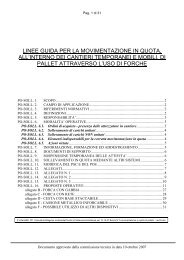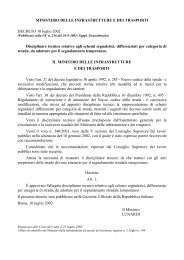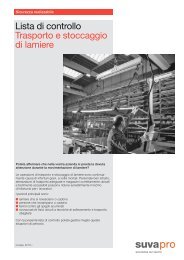Riconquistiamo il paesaggio - ACCA software SpA
Riconquistiamo il paesaggio - ACCA software SpA
Riconquistiamo il paesaggio - ACCA software SpA
Create successful ePaper yourself
Turn your PDF publications into a flip-book with our unique Google optimized e-Paper software.
178<br />
CAPITOLO III - Paesaggi d’Italia<br />
for the high environmental diversity that characterizes the region (Balletto & Casale 1991; Cowling<br />
et al. 1996; Preiss et al. 1997; Blondel & Aronson 1999; Heywood 1999; Lobo et al. 2001).<br />
In the last 40 years, a particular pattern of land-use/land-cover change has taken place in the<br />
Mediterranean basin, especially in Mediterranean Europe: plains are being increasingly ut<strong>il</strong>ized,<br />
h<strong>il</strong>ly and mountain areas are being abandoned by humans and naturally reforested, human settlements<br />
are quickly increasing along the coastline, with resident population doubling every 30<br />
years and tourist presence doubling every 15 years (UNEP 1989; Ales et al. 1992; Garcia-Ruiz<br />
et al. 1996; Debussche et al. 1999; MacDonald et al. 2000; Santos 2000; Lambin et al. 2003).<br />
These new patterns are largely independent from planned conservation strategies and appear<br />
to have a substantial impact on landscape and biodiversity (Ales et al. 1992; Covas & Blondel<br />
1998; Tellini-Florenzano 2004), especially because they affect large areas. However, most of the<br />
studies on land-use/land-cover change in the Mediterranean have concerned limited areas (Garcia-Ruiz<br />
et al. 1996; Preiss et al. 1997; Debussche et al. 1999), and have not analyzed the large<br />
scale effects of these patterns. Moreover, no spatially explicit analyses have considered the entire<br />
Italian peninsula, one of the most important areas for biodiversity conservation in Europe.<br />
1. Measuring land-use/land-cover change in Italy<br />
We used three land-use/land-cover maps (the Map of Land Cover produced from 1956 to 1968<br />
by the National Research Counc<strong>il</strong> – MLC1960 – and two Corine Land Cover maps – CLC –<br />
for 1990 and 2000) to measure landscape change in Italy over the last 40 years.<br />
We reclassified each map in order to obtain 8 land-use/land-cover categories (thematic generalization<br />
sensu Petit & Lambin 2002): “agricultural areas” (AGRICULTURE), “heterogeneous agricultural<br />
areas” (HETEROGENEOUS), “wooded cultivations” (WOODED), “forests” (FOREST),<br />
“pastures and grasslands” (PASTURE), “barren areas” (BARREN), “artificial areas” (ARTIFICIAL),<br />
and “water” (WATER). Different classification options were ava<strong>il</strong>able on the basis of the definitions<br />
of the land-use/land-cover classes in the original legends (e.g. the class “Chestnut woods”<br />
in the MLC1960 could be reclassified in the final legend as FOREST or as WOODED; on the<br />
contrary, the class “Artificial areas” in the MLC1960 can only be reclassified as ARTIFICIAL; Fig.<br />
1). We performed 6 alternative thematic aggregations for the CLC legend and 4 for the MLC1960,<br />
giving a total of 24 combinations for the time frame 1960-1990 (4 trials in 1960 by 6 trials in<br />
1990), and a total of 6 combinations for the time frame 1990-2000 (each trial in 1990 compared<br />
with the corresponding trial from 2000).<br />
To account for the inherently scale dependency of landscape patterns (Turner et al. 1989; Wu<br />
2004) we performed the analyses using 5 different cell sizes: 100 m, 200 m, 300 m, 400 m, and<br />
500 m. Thus, we obtained 120 possible combinations for 1960 versus 1990 (24 thematic combinations<br />
times 5 pixel sizes) and 30 possible combinations for 1990 versus 2000 (6 thematic<br />
combinations times 5 pixel sizes).<br />
We then performed a land-use/land-cover change detection for pairs of successive maps, using<br />
post-classification comparisons (Petit & Lambin 2002), and we obtained the mean change and<br />
the standard deviation for 1960 versus 1990 and for 1990 versus 2000. This method, despite its<br />
limitations (Coppin & Bauer 1996), was the only ava<strong>il</strong>able option, primar<strong>il</strong>y because no collateral<br />
spectral information was ava<strong>il</strong>able for 1960.<br />
From 1960 to 1990, 51.63% (± 2.31%) of the Italian peninsula changed from one land-use/landcover<br />
class to another. From 1990 to 2000, changes in land-use/land-cover occurred for 23.34%<br />
(± 1.51%) of the Italian peninsula (Fig. 2).<br />
In the 1960s, the agricultural land-use classes dominated the Italian landscape (58.12%), in par-





